Related Research Articles
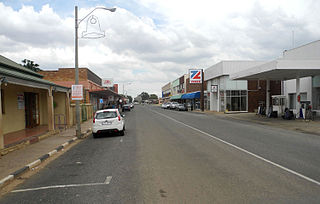
Coligny is a maize farming town situated next to the railway line between Lichtenburg and Johannesburg in North West Province of South Africa. The town is situated c. 27 kilometres (17 mi) south-east of Lichtenburg.

Harmony Gold is the largest gold mining company in South Africa. Harmony operates in South Africa and in Papua New Guinea. The company has nine underground mines, one open-pit mine and several surface operations in South Africa. In Papua New Guinea, it has Hidden Valley, an open-pit gold and silver mine and a 50% interest in the Morobe Mining Joint Venture, which includes the Wafi-Golpu project and extensive exploration tenements. Outside the joint venture, Harmony's own exploration portfolio focuses principally on highly prospective areas in Papua New Guinea.
Anglo American Platinum Limited is the world's largest primary producer of platinum, accounting for about 38% of the world's annual supply.
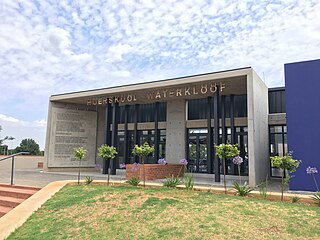
Hoërskool Waterkloof is a public Afrikaans medium co-educational high school situated in the eastern suburbs of Pretoria in the Gauteng province of South Africa. It is one of the most expensive Afrikaans medium schools, the fee per child amounting to R 32,400 per annum. It has received the award for academic school of the year from the Gauteng Department of Education (GDE) in 2004, 2008, 2009, 2010, 2011 and 2012. In 2018, it received the award for best academic school in Gauteng province, the ninth time since 2009. It claims a 100% matric pass rate for 30 consecutive years.

Crime in South Africa includes all violent and non-violent crimes that take place in the country of South Africa, or otherwise within its jurisdiction. When compared to other countries South Africa has notably high rates of violent crime and has a reputation for consistently having one of the highest murder rates in the world. The country also experiences high rates of organised crime relative to other countries.

Jagersfontein Mine was an open-pit mine in South Africa, located close to the town of Jagersfontein and about 110 kilometres south-west of Bloemfontein. Since it was first established in 1870, two of the ten biggest diamonds ever discovered, the Excelsior and the Reitz, were mined from Jagersfontein. The term "Jagers" has since been coined to denote the distinctive faint bluish tint of the gems from this mine. Among geologists, Jagersfontein is known as a kimberlite pipe, and a prime locality for mantle xenoliths, some of which are believed to have come from depths of 300–500 km (190–310 mi).

Mining in South Africa was once the main driving force behind the history and development of Africa's most advanced and richest economy. Large-scale and profitable mining started with the discovery of a diamond on the banks of the Orange River in 1867 by Erasmus Jacobs and the subsequent discovery of the Kimberley pipes a few years later. Gold rushes to Pilgrim's Rest and Barberton were precursors to the biggest discovery of all, the Main Reef/Main Reef Leader on Gerhardus Oosthuizen's farm Langlaagte, Portion C, in 1886, the Witwatersrand Gold Rush and the subsequent rapid development of the gold field there, the biggest of them all.

The Mining industry of Ghana accounts for 5% of the country's GDP and minerals make up 37% of total exports. Gold contributes over 90% of the total mineral exports. Thus, the main focus of Ghana's mining and minerals development industry remains focused on gold. Ghana is Africa's largest gold producer, producing 80.5 t in 2008. Ghana is also a major producer of bauxite, manganese and diamonds. Ghana has 20 large-scale mining companies producing gold, diamonds, bauxite and manganese; over 300 registered small scale mining groups; and 90 mine support service companies.Other mineral commodities produced in the country are natural gas, petroleum, salt, and silver.

Emfuleni Municipality is a local municipality within the Sedibeng District Municipality, in the Gauteng province of South Africa. It is the westernmost local municipality in the district, and covers an area of 987 km2 at the heart of the Vaal Triangle. It is located in the former industrial heartland of Gauteng which created employment and wealth for Sebokeng, Vanderbijlpark, Vereeniging, Three Rivers and Sharpeville. Its head offices are located at the corner of Klasie Havenga St and Frikkie Meyer Blvd, Vanderbijlpark. The municipality was founded in 1999.

The 2009 Harmony Gold mine deaths occurred in late May and early June 2009 in Free State province, South Africa. At least 82 miners, many from Lesotho, Mozambique and Zimbabwe, died from inhalation of poisonous gasses created by a May 18 fire in the mineshaft.
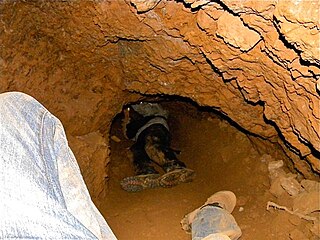
An artisanal miner or small-scale miner (ASM) is a subsistence miner who is not officially employed by a mining company, but works independently, mining minerals using their own resources, usually by hand.
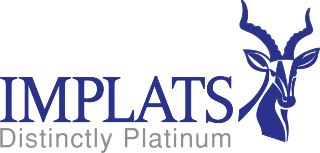
Impala Platinum Holdings Limited or Implats is a South African holding company that owns several companies which operate mines that produce platinum and platinum group metals, as well as nickel, copper and cobalt. Its most significant mine is the Impala mine in the North West province of South Africa. The company also owns or has interest in the Two Rivers mine and the Marula mine in the South Africa Bushveld Igneous Complex and the Mimosa mine and Zimplats in Zimbabwe, as well as the Impala Refining Services which smelts and refines metals for other companies. In December 2019, Impala Canada was formed, owned by the holding company, out of the acquisition of North American Palladium and its mine in Ontario, Canada.

Matjhabeng Municipality is a local municipality within the Lejweleputswa District Municipality, in the Free State province of South Africa. The municipality includes Welkom, Virginia, Odendaalsrus and Allanridge. Matjhabeng is a Sesotho word meaning "where nations meet". It is derived from the migrant labour system where people from various countries like Lesotho, Mozambique, etc. met to work in the mines.
Hoërskool Eldoraigne is a public Afrikaans medium co-educational high school situated in the suburb of Eldoraigne in Centurion in the Gauteng province of South Africa. It is one of the most academic schools in Gauteng and its learners are known as Eldo's.

The mining industry of Madagascar is mostly on a small scale, centred mainly around remote locations with large mineral deposits. Mining potential is noted in industrial and metallic minerals, energy, precious and semi-precious stones, as well as ornamental stone. The mining sector was neglected by the government for decades prior to the mid-2000s. In 2013, the mining industry, a main source of foreign investment, was struggling due to "low metals prices and distrustful companies", attributed to a 2009 coup.

Sibanye-Stillwater is a multinational mining and metals processing Group with a diverse portfolio of mining and processing operations and projects and investments across five continents. The Group is also one of the foremost global PGM auto catalytic recyclers and has interests in leading mine tailings retreatment operations.
Mosebenzi Joseph Zwane was the Minister of Mineral Resources of South Africa in the Second Cabinet of former President Jacob Zuma serving from 2015 until 2018. A controversial figure, Zwane resigned on 25 February 2018 following allegations of state capture and in particular his role in the Vrede Dairy Project, which helped bankroll the Gupta Family wedding.
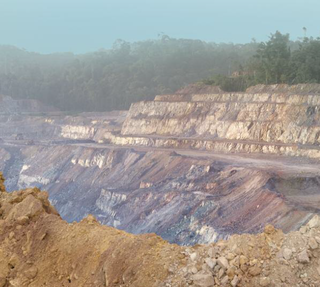
The mineral industry of Suriname makes up a large proportion of the country's economy. In 1916, the Aluminium Company of America began mining bauxite in the then Dutch colony of Surinam which over time became Suriname's main export.
At least 31 people are suspected to have died in a methane gas explosion at a disused gold mine in South Africa around the third week of May in 2023.
On 5 July 2023, a gas leak killed 17 people, including three children, in Boksburg, Ekurhuleni, Gauteng, South Africa. Ten other people were hospitalised.
References
- ↑ Greef, Kimon de (20 February 2023). "The Dystopian Underworld of South Africa's Illegal Gold Mines". The New Yorker.
- ↑ "Inside Labour | Zama zamas are the product of gross exploitation".
- ↑ "A Documentary, We are Zama Zama". wearezamazama.com. Retrieved 21 August 2023.
- ↑ "How lax legislative loopholes are allowing illegal mining to thrive in SA".
- ↑ Sani, Abubakar (2023-08-01). "Violent Shootout Between Rival Zama Zama Gangs Leaves Five Dead in Riverlea". NNN. Retrieved 2023-08-17.
- 1 2 Dlamini, Penwell (11 August 2022). "It will take 17 years to close shafts – Mantashe on illegal mining: Minister says illegal mining is an economic sabotage". South Africa. sowetanlive.co.za. SowetanLive. Retrieved 16 August 2022.
- ↑ "Illegal mining". Minerals Council South Africa. mineralscouncil.org.za. Retrieved 24 November 2020.
- 1 2 Adams, Tasneem; Bingwa, Bongani; Coetzer, Graham (2 August 2022). "'Zama-zamas are fueled by an insatiable appetite for gold'". 702.co.za. 702. Retrieved 3 August 2022.
- ↑ Maroela-redaksie (5 January 2021). "Nog klagte dalk teen drie wat glo goud smokkel". maroelamedia.co.za. Maroela Media. Retrieved 17 January 2021.
- ↑ Ledwaba, Karabo (1 August 2022). "Masemola assures tavern shootings are not linked, announces appointment of top cops". news24.com. City Press. Retrieved 16 August 2022.
- ↑ Tlou, Gift (21 December 2020). "Hawks intensifies fight against foreigners involved in illegal mining". MSN. IOL. Retrieved 21 December 2020.
- ↑ Cornelissen, Christel (13 November 2020). "Talle vas vir onwettige mynboubedrywighede". maroelamedia.co.za. Maroela Media. Retrieved 22 November 2020.
- ↑ "Nasionale Krugerwildtuin-Mynaansoek gestop". AfriForum. afriforum.co.za. 24 November 2020. Retrieved 3 December 2020.
- ↑ IOL Reporter (11 December 2020). "Seven suspects appear over R8m illicit gold refinery on West Rand". MSN. IOL. Retrieved 11 December 2020.
- ↑ Viljoen, Buks (23 December 2020). "Hawks nab 12 zama zamas at illicit gold refinery". news24.com. News24. Retrieved 25 February 2021.
- ↑ Martin, Alan (19 June 2019). "Solving South Africa's violent and costly Zama Zama problem". Daily Maverick, MSN. ISS Today. Retrieved 20 June 2019., see also: Uncovered: The dark world of the Zama Zamas, ENACT project, EU policy brief
- ↑ Bingwa, Bongani; Van Wyk, David; Mabuza, Mosa (27 November 2018). "Illegal mining brings Johannesburg to the brink of a massive disaster (702)". lifepodcasts.fm. Retrieved 21 October 2020.
- ↑ "BMA will be part of stopping illegal mining". defenceweb.co.za. defenceWeb. Retrieved 11 October 2023.